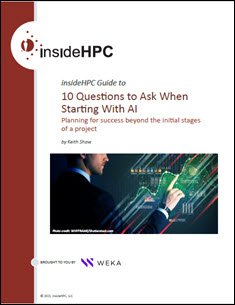
Image credit: Thor Swift, Berkeley Lab
By Katie Elyce Jones, founder and editor, PillarQ
Last November, the National Energy Research Scientific Computing Center (NERSC) at Lawrence Berkeley National Laboratory launched its QIS@Perlmutter program to provide researchers working on quantum information science (QIS) problems with supercomputing resources, while also exploring how QIS could benefit high-performance computing (HPC).
NERSC is a U.S. Department of Energy (DOE) computing facility that provides supercomputing and other scientific computing resources to thousands of researchers each year. Among these researchers, QIS experts from government, industry, and academia are interested in using supercomputers at NERSC and other HPC centers to advance quantum technologies and study untapped questions in quantum-driven sciences such as materials, chemistry, and physics.
“We see quantum computing becoming an increasingly important part of our users’ workflows,” said Katie Klymko, a NERSC Advanced Technologies staff member working on the integration of HPC and quantum computing. “In the near term, we anticipate that our users will continue to push the boundaries of what can be done classically to accelerate quantum computing, while testing small parts of the applications on near-term quantum devices. Longer term, we think that parts of the current codes being run on NERSC’s systems could be accelerated on quantum processors, expanding the scope of science questions that are currently within reach.”
The QIS@Perlmutter program allocated 250,000 GPU hours on the center’s new supercomputer, Perlmutter, as part of a larger effort led by the Advanced Technologies group called Quantum@NERSC. Perlmutter includes more than 6,000 NVIDIA A100 tensor core GPUs, which are compatible with NVIDIA’s cuQuantum library for QIS and perform well for artificial intelligence (AI) applications.
Following a proposal review process, NERSC announced 16 QIS projects in January. This 2022 cohort ranged from quantum simulation of materials and chemical systems, algorithms for compilation of quantum circuits, error mitigation for quantum computing, and development and testing of hybrid quantum-classical algorithms, with principal investigators (PIs) representing fields such as materials, computer science, and applied mathematics.
 Now, the program is seeing results through papers, preprints, and software releases. Despite the program’s output, Klymko advised that there are still massive challenges facing the integration of quantum and HPC and NERSC remains in the exploratory phase.
Now, the program is seeing results through papers, preprints, and software releases. Despite the program’s output, Klymko advised that there are still massive challenges facing the integration of quantum and HPC and NERSC remains in the exploratory phase.
In October, NERSC held a Quantum for Science day event, where PIs from QIS projects presented their initial results. Advanced Technologies group staff member Daan Camps discussed the initial results from three projects.
Novel quantum circuit cutting algorithms for PennyLane
 A team led by Lee J. O’Riordan of Xanadu—the Toronto-based photonic quantum computing and software company—developed and tested novel quantum circuit cutting algorithms for Xanadu’s PennyLane software suite for programming quantum computers.
A team led by Lee J. O’Riordan of Xanadu—the Toronto-based photonic quantum computing and software company—developed and tested novel quantum circuit cutting algorithms for Xanadu’s PennyLane software suite for programming quantum computers.
Large quantum circuits are difficult to implement on current quantum computers and become increasingly error prone at larger sizes. Camps explained that by cutting large circuits into smaller ones more suitable for smaller quantum computers and using classical computing to stitch the results back together, researchers can use this hybrid workflow to solve more complex problems.
“Their team used the GPUs on Perlmutter as proxies for a large number of real quantum computers, where each GPU was capable of simulating on the order of 30 qubits,” Camps said.
Watch Lee J. O’Riordan’s presentation for Quantum for Science Day.
Read the paper “Fast quantum circuit cutting with randomized measurements” on arXiv.
Accelerated Quantum Circuit Simulator
For another circuit simulation project, Camps worked with Berkeley Lab colleague Roel Van Beeumen to optimize their own quantum circuit simulator, QCLAB++, for GPUs.
QCLAB++ is a C++ package for creating and representing quantum circuits. In particular, the code relies on state vector simulators that mathematically describe the state of the quantum system at any given point along the circuit.
Camps and Van Beeumen implemented the GPU-accelerated QCLAB++ for two types of quantum circuits—Fourier transform and Hamiltonian. They then benchmarked the results against other quantum circuit simulators, such as NVIDIA’s cuQuantum simulators, running on both Perlmutter’s CPUs and GPUs. QCLAB++ performed particularly well at low qubit counts and remained competitive at higher qubit counts, with increased performance on GPUs versus CPUs.
“Our tests have shown that our code is competitive with other state vector simulators on a variety of benchmarking circuits,” Camps said. “Our GPU-accelerated code will be released soon and the QIS@Perlmutter program really enabled us to drive the development.”
Watch Roel Van Beeumen’s presentation for Quantum for Science Day.
Optimized Quantum Search Algorithms for Noisy Quantum Devices
 A project led by Kwangmin Yu of Brookhaven National Laboratory studied and optimized the performance of the quantum search algorithm known as Grover’s algorithm for noisy quantum devices as part of a larger project on quantum Monte Carlo integration (QMCI).
A project led by Kwangmin Yu of Brookhaven National Laboratory studied and optimized the performance of the quantum search algorithm known as Grover’s algorithm for noisy quantum devices as part of a larger project on quantum Monte Carlo integration (QMCI).
Quantum search is one of the core parts of QMCI, which can then be used to study complex quantum systems in a range of applications in science, finance, and more. One of the earliest and well-known algorithms for quantum computing, Grover’s algorithm can rapidly speed list or database searches, helping solve large-scale problems with many variables. However, like other foundational quantum algorithms, such as Shor’s algorithm used for factorization, Grover’s algorithm is difficult to implement on current quantum hardware. These near-term “noisy” devices are sensitive to their environment and prone to losing their quantum state (decoherence) but are still critical to today’s quantum users.
After conducting QMCI experiments on commercial quantum computers, simulations on Perlmutter were used to validate and check the results of their experiments at a large scale, Camps said. “Dr. Yu’s team used their compute time on Perlmutter to develop pre- and post-processing for distributed QMCI in order to solve large decision-making and optimization problems.”
What’s Next for QIS@Perlmutter?
Although a 2023 QIS@Perlmutter program has not been announced, Camps said that the 2022 program has been a success and NERSC will continue to support QIS users through its Energy Research Computing Allocations Process.
PillarQ is a research news and analysis publication about discovery and innovation in the fields of quantum, artificial intelligence, and data science.



